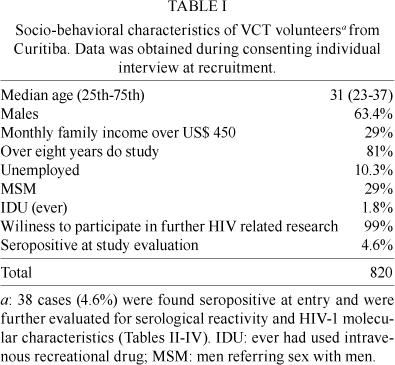As in many areas of Brazil, the AIDS epidemic in Curitiba is relatively stable, but surveillance is important to support public policy. The molecular characteristics of HIV may be instrumental for monitoring epidemic trends. We evaluated plasma HIV-1 RNA (n = 37) from 38 cases presenting with positive serology, who were among 820 consenting volunteers visiting the downtown counselling and serology testing centre. Seroprevalence was 4.6% (CI 95% 3.2-6.3) and the estimated HIV incidence, as defined by the BED assay, was 2.86 persons/years (CI 95% 1.04-4.68). An additional set of contemporaneous, anonymous samples from a local laboratory was also analysed (n = 20). Regions of the HIV-1 polymerase (n = 57) and envelope (n = 34) were evaluated for subtyping, determination of mosaic structure, primary drug resistance mutations (pDRM), envelope V3 loop motifs and amino acid signatures related to viral tropism. HIV-1 clade B was observed in 53% of cases; HIV-1C in 30% and BC mosaics in 14%, with one F genome and one CF mosaic. Clade C infection was associated with recent infections among males (p < 0.03). Stanford surveillance pDRM was observed in 8.8% of sequences, with 7% showing high level resistance to at least one antiretroviral drug. Tropism for CXCR4 co-receptor was predicted in 18% of envelope sequences, which were exclusively among clade B genomes and cases with serological reactivity to chronic infection.
epidemiology; antiretroviral resistance; genetic diversity; HIV-1; tropism; Brazil







